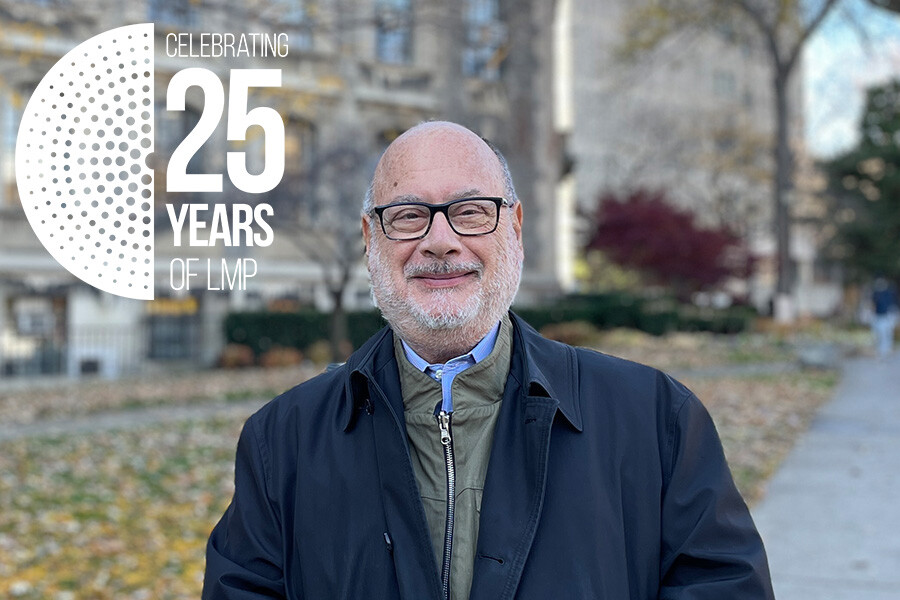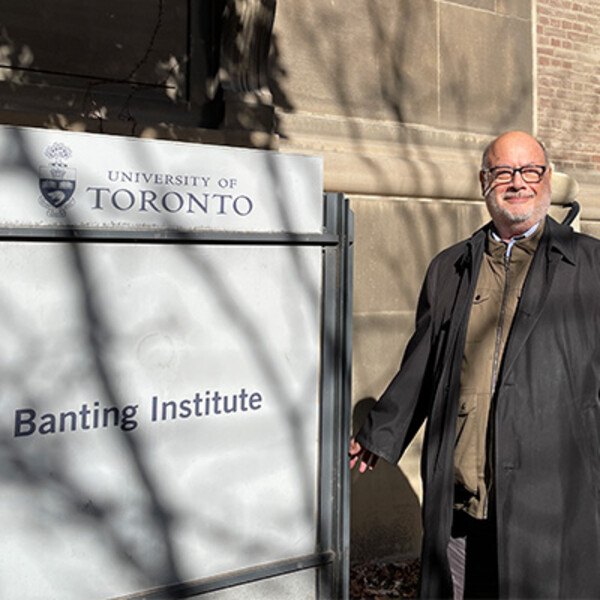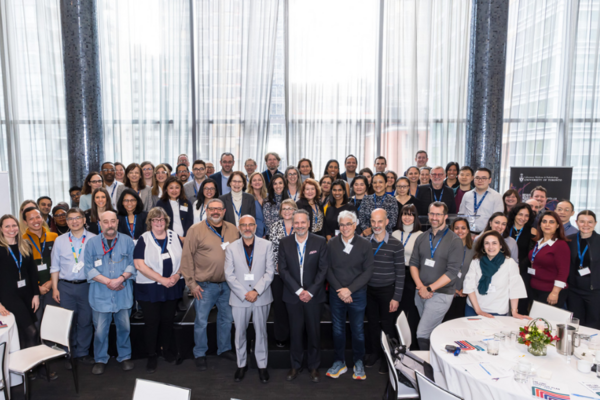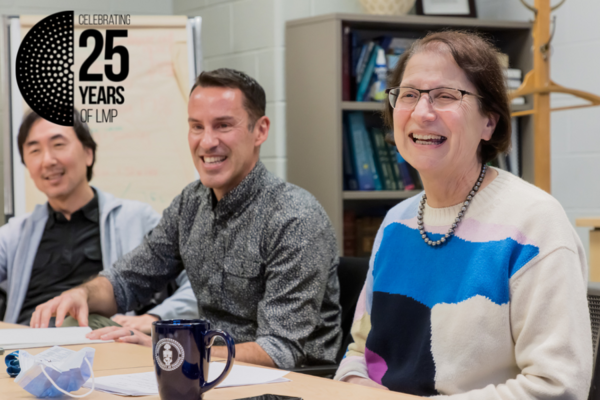Partnerships at the heart of a new department: the creation of LMP

This is the first in our series of Chairs interviews to celebrate 25 years of LMP. Visit the celebration web page to find out more.
“When you look at LMP, what its creation is really all about is building partnerships between different fields and disciplines of Laboratory Medicine,” reminisces Founding Chair Dr. Avrum Gotlieb on the creation of the Department of Laboratory Medicine and Pathobiology at the University of Toronto 25 years ago.
Officially established on July 1, 1997, the new Department of Laboratory Medicine and Pathobiology (LMP) had gone through a rigorous process to ensure its viability and support. Created from a merger of the existing Departments of Pathology, Clinical Biochemistry and Clinical Microbiology, it became a unique blend of basic and clinical biomedical science.
“The aim was to create an entity within the Faculty of Medicine (now the Temerty Faculty of Medicine) that was large enough to be viable and provide stability across the board in Laboratory Medicine”, explains Gotlieb, “To allow these great departments to become better and promote more excellence in Laboratory Medicine due to synergies in administration, research, education, and training at all levels”.
The Dean of the Faculty, Arnie Aberman, met with Dr. Andrew Baines (Chair of the Department of Clinical Biochemistry), and Dr. Malcolm Silver (Chair of the Department of Pathology) in June 1994 to discuss a potential merger. A merger had been suggested previously in 1987 but strongly opposed by the departments involved. However, with advances in molecular biology breaking down boundaries, and the trend of hospital departments merging Laboratory Medicine functions, the idea was revisited.
To ensure its success, support for the merger was thoroughly investigated via a committee headed by Dr. Peter Pinkerton who was appointed in both departments. His recommendation in 1995 was to proceed, and to include the medical microbiologists from Department of Microbiology which was facing an uncertain future at the time. Dr. Bernard Langer of the Department of Surgery then headed a committee to develop a merger proposal.
“I was quite happy in my own world of Pathology and vascular biology. I wasn’t opposed to the merger, but at the time I just didn’t see a need for it – things seemed to be going well in Pathology so why should it change?” says Gotlieb. The Dean surprised him by asking that he lead the merger, becoming interim Chair of both Pathology and Clinical Biochemistry. “I like a challenge and creating new ventures so I thought it would be interesting. It seemed fairly well supported by the Faculty of Medicine. I was interested in Pathology and had never really thought about Laboratory Medicine as a whole before, but I could see this was a defining moment and a great challenge”. The Dean, however, did warn Gotlieb not to take the position as interim Chair if he had ambitions of becoming the Chair of the newly formed LMP as he would “create enemies”. But Gotlieb replied that “If we’re going to do it, I want it done right with a strong, sustainable academic mission.”
Gotlieb understood that the three areas of Pathology, Chemistry and Microbiology had their own histories, cultures and ways of doing things. The best way forward was to be inclusive and transparent throughout the process. Division leads were appointed: Clinical Biochemistry (Dr. Eleftherios Diamandis), Medical Microbiology (Dr. Don Low) and Pathology (Dr. Wedad Hanna). Committees were struck for infrastructure development - the graduate and postgraduate programs, research and more - and all included members from each division.

“The initial impulse was to create one department – tear down all the silos. I realized it was wrong, we had three different groups with rich cultures and traditions of their own. We couldn’t just erase that if we wanted to succeed. Because we’re so diverse in terms of expertise and interests, every little piece becomes important. We also had some elements that fitted into the divisional structure well, like our postgraduate programs, many of which had a long history,” explains Gotlieb.
The official Divisions faded over time as the Department of LMP grew its own culture and cohesiveness, but the legacy of the three original departments remains. The newly formed department restructured awards and held events and programs to help build bonds, such as the Annual Celebration of Excellence and the student vs faculty volleyball games (now making a return after a pandemic hiatus).
The goal of the merger was to create an exceptional academic department. Gotlieb managed to secure 10 tenure track appointments, an unusually high number for a new department in Medicine. These positions went to high-caliber researchers involved in growing the graduate research program and teaching in the newly formed Specialist Program in Pathobiology, launched in 2000. Created by Dr. Douglas Templeton and Dr. Gotlieb, they protected the small classes and the elite entry requirements to create an undergraduate program focused on academic excellence. Many of the undergraduates went on to careers in biomedical research and clinical medicine.
The merger also enabled and improved many partnerships. “We faced a lot of threats mainly to the hospital clinical side – the trend was to merge labs and consolidate diagnostic services, bringing in more private sector. By having one strong voice we couldn’t be divided and conquered and were able to maintain a strong academic presence at the hospitals. In our teaching programs, we were able to protect training resources and space for residents and graduate students. When interacting with the Government, we had strength in numbers and in successful clinical practice,” says Gotlieb. “I also think having one Chair and department as opposed to three made it easier for those relationships between university and hospital to strengthen.”
The basic research element of the department grew, attracting more excellent fundamental researchers which in turn strengthened and expanded the graduate program from 150 students in 2004 to over 250 now, many of whom are award-winning students. The graduate students and their programs were, according to Gotlieb, the easiest part of the merger. “They took to it like a duck to water, forming the CLAMPS student society and becoming a core part of LMP straight away.”
And the most challenging part of the merger? “The name! I always knew it would be a problem, so I left it to the very end. I wanted us to get everything right and looking good first, then, if there was opposition to the name, it was less likely to ruin our strong strategic plan,” noted Gotlieb.
A committee was formed just to choose a name – no one wanted the historical department names included, it had to be new. Laboratory Medicine was new but reflected only the clinical side, Pathobiology was suggested to help draw in the basic sciences. “People were calling me a traitor to the cause for removing Pathology, but it couldn’t stay. We definitely competed with the Institute of Health Policy, Management and Evaluation (IHPME) for the most complicated Faculty of Medicine name!” he laughs.
When asked what made the merger successful, Gotlieb comments on how important voices were – there were many committees but that ensured diverse opinions were expressed and considered. “We wanted everyone to feel this was their department as much as we could and the building of partnerships within that was essential. We had a plan but were flexible enough to tweak our course when needed. Generally speaking, 90% of faculty were satisfied with the merger. They saw value in it and recognized it made academic sense”.
Gotlieb was Chair until 2009 when Dr. Richard Hegele took over but returned in 2016 while the search for current Chair Dr. Rita Kandel took place. “It was nice to see what worked and what didn’t – it was gratifying to see faculty I hired at the start doing well and students achieving success and starting their careers”.
Most of all, he is pleased to see, and be part of, what LMP has become. “I’m proud we created something new and I was able to watch it grow. That’s been a wonderful thing. I think we stand out in Canada and have a strong international reputation. We are unique and have an enormous amount of talent”.
Thank you to “Partnership for Excellence: Medicine at the University of Toronto and Academic Hospitals” by Edward Shorter for some of the background to this story.
View the History of LMP timeline! (PDF)
Read the interviews with the Chairs of LMP:



